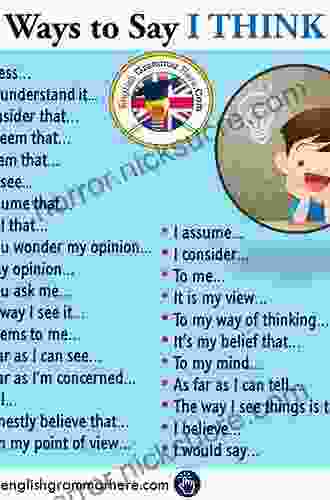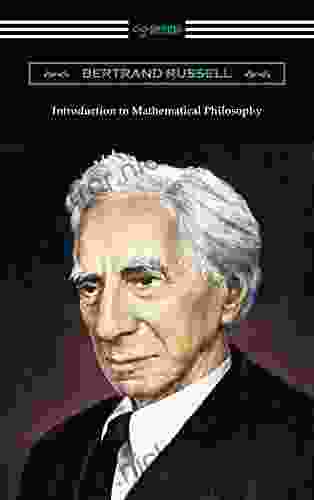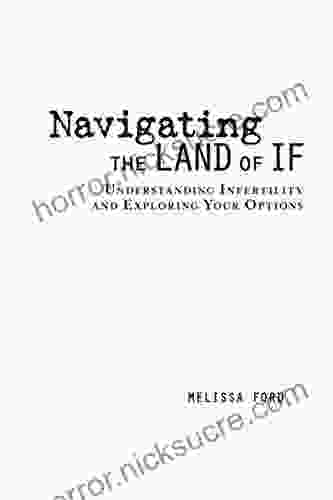What to Say and Why: A Comprehensive Guide to Effective Communication

Effective communication is a cornerstone of personal and professional success. It enables us to convey our thoughts, ideas, and emotions clearly and persuasively. When we communicate effectively, we build stronger relationships, advance our careers, and make a meaningful impact on the world around us.
This comprehensive guide will delve into the essential elements of what to say and why, empowering you to communicate with confidence, purpose, and impact. We will explore the art of crafting compelling messages, understanding your audience, and adapting your communication style to different contexts.
4.6 out of 5
| Language | : | English |
| File size | : | 3030 KB |
| Text-to-Speech | : | Enabled |
| Screen Reader | : | Supported |
| Enhanced typesetting | : | Enabled |
| Word Wise | : | Enabled |
| Print length | : | 355 pages |
Chapter 1: The Power of Words
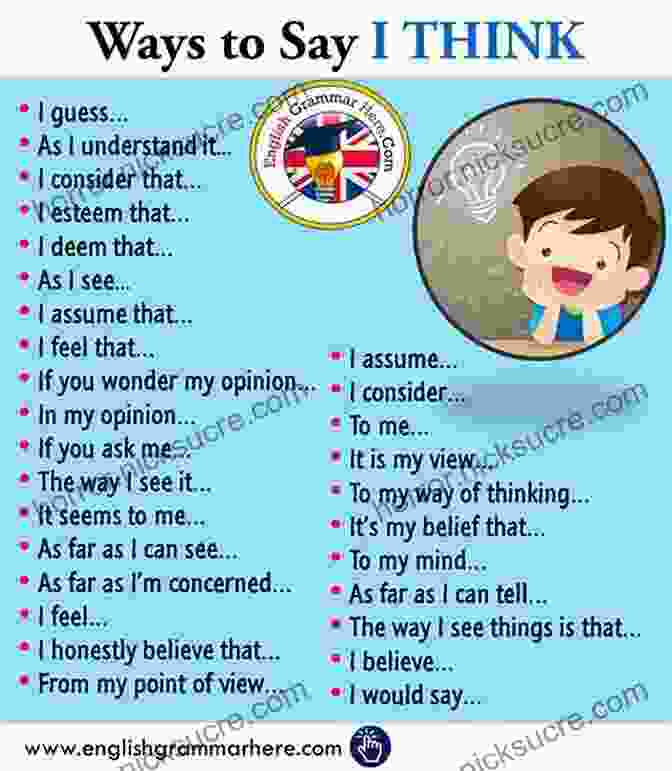
A. The Magic of Language
Words are the building blocks of communication. They have the power to evoke emotions, convey ideas, and shape perceptions. Understanding the nuances of language allows us to craft messages that resonate deeply with our audience.
B. Choosing the Right Words
Effective communication begins with selecting the appropriate words. Consider the context, your audience's demographics, and the desired impact when choosing your vocabulary. Concise and specific language conveys clarity, while vivid and evocative language captures attention and imagination.
C. The Art of Precision
Avoid ambiguous or vague language that can lead to misunderstandings. Use precise terms that convey your meaning accurately and unambiguously. This precision ensures that your messages are easily understood and remembered.
Chapter 2: Understanding Your Audience
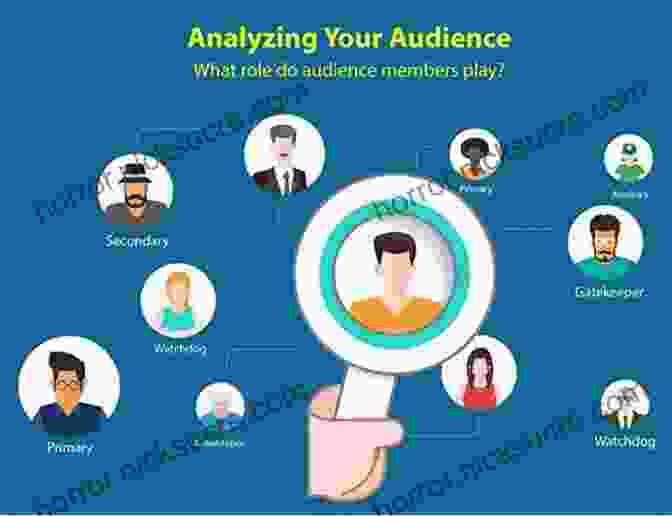
A. Demographics and Psychographics
Consider your audience's age, gender, education level, and cultural background. Understanding these demographics helps you tailor your language and tone to resonate with their interests and perspectives.
B. Purpose and Motivation
Why are you communicating? What do you want your audience to think, feel, or do? Identifying your purpose and your audience's motivations guides your message development and delivery.
C. Cultural and Contextual Considerations
Be aware of cultural norms and language conventions when communicating with people from different backgrounds. Respectful and sensitive language fosters understanding and builds rapport.
Chapter 3: Adapting Your Communication Style

A. Formal and Informal Styles
Formal communication, often used in business and academic settings, requires adherence to specific language conventions. Informal communication, on the other hand, is more conversational and relaxed. Adapt your style to the context and audience.
B. Adjusting Tone and Register
The tone of your communication conveys your attitude and intent. Choose a tone that is appropriate for the situation, whether it's professional, humorous, or empathetic. The register, or level of formality, should also match the context.
C. Nonverbal Communication
Body language, facial expressions, and eye contact play a significant role in effective communication. Ensure that your nonverbal cues align with your verbal message, enhancing your credibility and impact.
Chapter 4: Crafting Compelling Messages

A. The Message Structure
Craft messages that follow a clear and logical structure. Begin with an engaging hook to capture attention, provide supporting evidence and examples to build credibility, and conclude with a powerful call to action.
B. The Art of Storytelling
Stories are a powerful way to connect with your audience on an emotional level. Incorporate stories into your messages to illustrate your points, evoke empathy, and make a lasting impact.
C. Engaging Visuals
Visuals, such as graphs, charts, and images, can enhance the clarity and memorability of your messages. Use them judiciously to support your arguments and make your communication more visually appealing.
Chapter 5: The Importance of Feedback
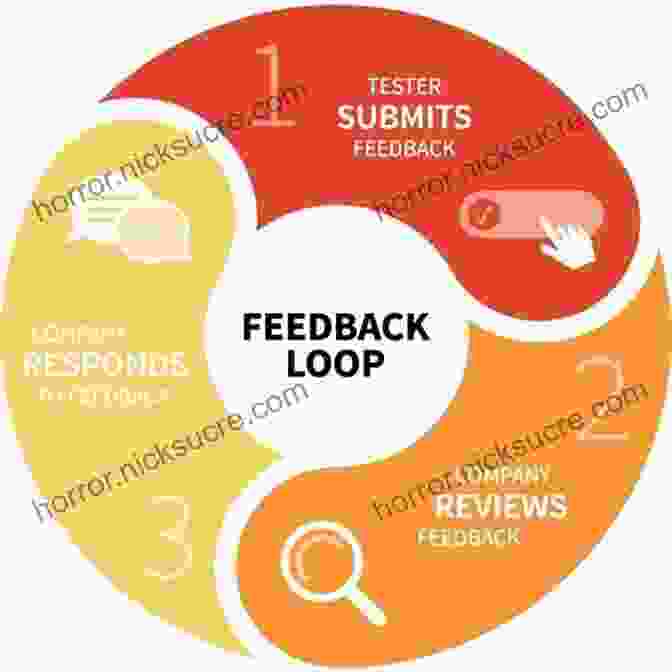
A. Active Listening and Observation
Seek feedback from your audience through active listening and observation. Pay attention to their verbal and nonverbal responses to gauge their understanding and engagement.
B. Gathering and Analyzing Feedback
Use surveys, questionnaires, and other methods to gather feedback on the effectiveness of your communication. Analyze this feedback to identify areas for improvement and enhance your future communication efforts.
C. Continuous Improvement
Effective communication is an ongoing process. Continuously seek feedback and make adjustments to your communication strategies to improve your impact and achieve desired outcomes.
Effective communication is an essential skill that empowers us to connect, influence, and inspire. This comprehensive guide has provided you with a wealth of insights and practical tips on what to say and why. By embracing the principles of powerful language, understanding your audience, adapting your style, crafting compelling messages, and seeking feedback, you can elevate your communication abilities and make a meaningful impact on your personal and professional life.
Remember, effective communication is not just about delivering information; it's about connecting with others, building relationships, and creating positive change. As you continue your communication journey, may this guide serve as a valuable resource in your ongoing pursuit of excellence.
4.6 out of 5
| Language | : | English |
| File size | : | 3030 KB |
| Text-to-Speech | : | Enabled |
| Screen Reader | : | Supported |
| Enhanced typesetting | : | Enabled |
| Word Wise | : | Enabled |
| Print length | : | 355 pages |
Do you want to contribute by writing guest posts on this blog?
Please contact us and send us a resume of previous articles that you have written.
 Fiction
Fiction Non Fiction
Non Fiction Romance
Romance Mystery
Mystery Thriller
Thriller SciFi
SciFi Fantasy
Fantasy Horror
Horror Biography
Biography Selfhelp
Selfhelp Business
Business History
History Classics
Classics Poetry
Poetry Childrens
Childrens Young Adult
Young Adult Educational
Educational Cooking
Cooking Travel
Travel Lifestyle
Lifestyle Spirituality
Spirituality Health
Health Fitness
Fitness Technology
Technology Science
Science Arts
Arts Crafts
Crafts DIY
DIY Gardening
Gardening Petcare
Petcare Kim John Payne
Kim John Payne Mike Settele
Mike Settele Jo Boaler
Jo Boaler Steve Schwartz
Steve Schwartz John R Bruning
John R Bruning Percy Keese Fitzhugh
Percy Keese Fitzhugh Kelli L Ferguson
Kelli L Ferguson Khoi Tu
Khoi Tu Rough Guides
Rough Guides Ken M Harrison
Ken M Harrison Ashley Lecker
Ashley Lecker Scott Wilson
Scott Wilson Tim Tebow
Tim Tebow Prof Dr Wa Liebenberg
Prof Dr Wa Liebenberg Joy Hendry
Joy Hendry Martin Lee Abbott
Martin Lee Abbott Bernadette Noll
Bernadette Noll Ahlia Rose
Ahlia Rose Declan Lyons
Declan Lyons L H Stacey
L H Stacey Jane Bottomley
Jane Bottomley Ilya Grigorik
Ilya Grigorik Janisse Ray
Janisse Ray Department Of The Army
Department Of The Army Christy Mihaly
Christy Mihaly T L Christianson
T L Christianson John Biggar
John Biggar Stephen Smith
Stephen Smith Molly Mills
Molly Mills Kate Williams
Kate Williams John Mandel
John Mandel Daniel Muijs
Daniel Muijs Lori Ashley Taylor
Lori Ashley Taylor Karen J Rooney
Karen J Rooney Kristin Cashore
Kristin Cashore Justin Roethlingshoefer
Justin Roethlingshoefer Ethan Sawyer
Ethan Sawyer Tracy Lash Decrosta
Tracy Lash Decrosta Editors Of Martha Stewart Living
Editors Of Martha Stewart Living Stephan A Hoeller
Stephan A Hoeller Hansa Bhargava
Hansa Bhargava Chanda Hahn
Chanda Hahn Sona Charaipotra
Sona Charaipotra Izaak Walton
Izaak Walton Eileen Kennedy Moore
Eileen Kennedy Moore Christine Desdemaines Hugon
Christine Desdemaines Hugon Ben Smith
Ben Smith Stephen Jenkinson
Stephen Jenkinson Michael S Kelly
Michael S Kelly Scott Imhoff Phd
Scott Imhoff Phd Will Wraxall
Will Wraxall Benjamin Smith
Benjamin Smith Lisa Mckay
Lisa Mckay Rainbow Rowell
Rainbow Rowell Christy Teglo
Christy Teglo Ellen Galinsky
Ellen Galinsky Daniel Boyarin
Daniel Boyarin Natasha D Lane
Natasha D Lane Christy Dorrity
Christy Dorrity Tomoko Fuse
Tomoko Fuse Zoe S
Zoe S Dudley Wright
Dudley Wright Rich Roll
Rich Roll Jonathan Knight
Jonathan Knight Bob Hazard
Bob Hazard Rebecca Collins
Rebecca Collins Seth A Roberts
Seth A Roberts Esther Hicks
Esther Hicks Brent Majcher
Brent Majcher Martijn Konings
Martijn Konings Shanterra Mcbride
Shanterra Mcbride John Taylor
John Taylor Oleg Senkov
Oleg Senkov Dennis Fisher
Dennis Fisher Helen Leigh
Helen Leigh Tom Dodd
Tom Dodd Mike Veny
Mike Veny Sandy Glenn
Sandy Glenn Wesley C Salmon
Wesley C Salmon Monica Swanson
Monica Swanson Josh Gates
Josh Gates Gerad Kite
Gerad Kite Peter Isler
Peter Isler Paul Bellow
Paul Bellow Cokie Roberts
Cokie Roberts Carol Walters
Carol Walters Bethany Warren
Bethany Warren Jean Louis Vidal
Jean Louis Vidal Jamie C Martin
Jamie C Martin Mario Cardano
Mario Cardano Kiera Cass
Kiera Cass Emily Glickman
Emily Glickman Troy Horne
Troy Horne Rachael Denhollander
Rachael Denhollander Janice K Ledford
Janice K Ledford Shelia Craig Whiteman Pt Dpt Clt
Shelia Craig Whiteman Pt Dpt Clt Jay Kirk
Jay Kirk Julie Urbanski
Julie Urbanski Robert W Smith
Robert W Smith Art Friedman
Art Friedman Dan Inosanto
Dan Inosanto Jessica Misener
Jessica Misener Roger Fredericks
Roger Fredericks Mark Csikszentmihalyi
Mark Csikszentmihalyi Kevin Johnson
Kevin Johnson Benjamin Johnston
Benjamin Johnston Lsatmax Lsat Prep
Lsatmax Lsat Prep Mary V Solanto
Mary V Solanto Kalliope Barlis
Kalliope Barlis Eric Provan
Eric Provan Vivienne Edgecombe
Vivienne Edgecombe Brandon Sanderson
Brandon Sanderson Kenneth R Miller
Kenneth R Miller Bell Hooks
Bell Hooks Blythe Lucero
Blythe Lucero Hillary Sadler
Hillary Sadler Adam Griffith
Adam Griffith Tim Ingold
Tim Ingold Joel Hooks
Joel Hooks Brigid Kemmerer
Brigid Kemmerer Meghan Casey
Meghan Casey Melissa De La Cruz
Melissa De La Cruz Erin Eileen Leigh
Erin Eileen Leigh Kevin Easley
Kevin Easley Roxanne Reid
Roxanne Reid Nsca National Strength Conditioning Association
Nsca National Strength Conditioning Association Mark Lutz
Mark Lutz Christopher Hill
Christopher Hill Bb Easton
Bb Easton Scott Wetzler
Scott Wetzler Deanna Raybourn
Deanna Raybourn Nicholas Griffin
Nicholas Griffin David Diaz
David Diaz T Edward Nickens
T Edward Nickens Jo Carol Claborn
Jo Carol Claborn Stephen K Hayes
Stephen K Hayes Kim Vopni
Kim Vopni Stacey Barrett
Stacey Barrett James Blake
James Blake Shelley C Safian
Shelley C Safian Elaine Stillerman
Elaine Stillerman James Henry Breasted
James Henry Breasted Gerard Taylor
Gerard Taylor Peggy J Martin
Peggy J Martin Suzanne Bender
Suzanne Bender Albert S Tarendash
Albert S Tarendash Jenson Button
Jenson Button Brian Reddington
Brian Reddington Maggie Dent
Maggie Dent David Lawson Phd
David Lawson Phd Joe Baird
Joe Baird Farley Mowat
Farley Mowat Lauren Wells
Lauren Wells Valentin Nugmanov
Valentin Nugmanov Sally Moran
Sally Moran Eliza Hof
Eliza Hof Mindy Cockeram
Mindy Cockeram L T C Rolt
L T C Rolt Theodore Gray
Theodore Gray Debbie Marks
Debbie Marks Zecharia Sitchin
Zecharia Sitchin Christian Beamish
Christian Beamish Stephanie Baier
Stephanie Baier Elizabeth Verdick
Elizabeth Verdick Educational Testing Service
Educational Testing Service Colin Gordon
Colin Gordon Frank Ayres
Frank Ayres Peter Gieler
Peter Gieler John Dickie
John Dickie Chuck Lukacs
Chuck Lukacs Les Carter
Les Carter Beth Reekles
Beth Reekles Graham Burgess
Graham Burgess Ellen Schreiber
Ellen Schreiber Benjamin Southerland
Benjamin Southerland Bill W
Bill W Heroes Of The Art
Heroes Of The Art Virginia Smith Harvey
Virginia Smith Harvey Phil Davies
Phil Davies William J Callaway
William J Callaway Mitch Terrusa
Mitch Terrusa Ben Gillman
Ben Gillman Margaret E Murie
Margaret E Murie Patricia Hachten Wee
Patricia Hachten Wee Phil Martin
Phil Martin Rosalie Knecht
Rosalie Knecht Sharon Bergen
Sharon Bergen Henri De Lestapis
Henri De Lestapis Kara Richardson Whitely
Kara Richardson Whitely Prem Carnot
Prem Carnot Thomas Norman Dewolf
Thomas Norman Dewolf Stefanie Reinhold
Stefanie Reinhold Lesley Pyne
Lesley Pyne Rich Johnson
Rich Johnson Patti Jean
Patti Jean Ben Worthington
Ben Worthington Knowledge Flow
Knowledge Flow Bernard Lewis
Bernard Lewis Rick Wiebe
Rick Wiebe Kurt Jacobs
Kurt Jacobs Fran Zimniuch
Fran Zimniuch Richard Dawkins
Richard Dawkins Rose Kearney Nunnery
Rose Kearney Nunnery John H Holland
John H Holland William Cane
William Cane Maggie Kline
Maggie Kline Hannah Witton
Hannah Witton Maggie Oakes
Maggie Oakes Behan Gifford
Behan Gifford Michael P Nordvall
Michael P Nordvall Julie L Hall
Julie L Hall Emily Alison
Emily Alison Jeremy Lent
Jeremy Lent Catherine White
Catherine White Kindle Edition
Kindle Edition Stuart James Amei
Stuart James Amei Don L Gates
Don L Gates C C Hunter
C C Hunter David Quammen
David Quammen Haya Leah Molnar
Haya Leah Molnar Brett Cyrgalis
Brett Cyrgalis Bob Raynor
Bob Raynor Rui Zhi Dong
Rui Zhi Dong Bill Jamison
Bill Jamison Matthew Stein
Matthew Stein Peter Brown Hoffmeister
Peter Brown Hoffmeister Beth Baker
Beth Baker David Sadker
David Sadker Lene Fogelberg
Lene Fogelberg Melissa Ford
Melissa Ford Chris Batha
Chris Batha Sherry Turkle
Sherry Turkle Gaby Melian
Gaby Melian Kris Wilder
Kris Wilder Tiffany Vincent
Tiffany Vincent Jonathan Wolf
Jonathan Wolf Will Oxley
Will Oxley Lisa Rene Reynolds Phd
Lisa Rene Reynolds Phd Shelby Evans
Shelby Evans Fr Mike Driscoll
Fr Mike Driscoll Joe Farinaccio
Joe Farinaccio Joe Baker
Joe Baker John D Barrow
John D Barrow Laura Bashar
Laura Bashar Tamarack Song
Tamarack Song Richard G Lomax
Richard G Lomax Makiia Lucier
Makiia Lucier Ben Hoppe
Ben Hoppe Portia Iversen
Portia Iversen John Grasso
John Grasso Ciara Attwell
Ciara Attwell Sarah Spencer
Sarah Spencer Chris Mcintyre
Chris Mcintyre Ben Crawford
Ben Crawford Kyle Simpson
Kyle Simpson Nancy Redd
Nancy Redd Bertil Gustafsson
Bertil Gustafsson Si Sheppard
Si Sheppard Sheila Lukins
Sheila Lukins Sarah Maclean
Sarah Maclean Jon M Sweeney
Jon M Sweeney Rosamund Hodge
Rosamund Hodge Leila Kalmbach
Leila Kalmbach Frank Galli
Frank Galli Tony Frezza
Tony Frezza Adam Stevens
Adam Stevens Leia Stone
Leia Stone Dorian Gerhold
Dorian Gerhold John C Lundell
John C Lundell Catherine B Walker
Catherine B Walker Bertrand Russell
Bertrand Russell Liz Robbins
Liz Robbins Rick Rinehart
Rick Rinehart Dan R Lynch
Dan R Lynch Gary Oberg
Gary Oberg Carol Devine
Carol Devine Dave Rearwin
Dave Rearwin Stefanie Molin
Stefanie Molin Simon Armitage
Simon Armitage Cathy Jackson
Cathy Jackson Gooseberry Patch
Gooseberry Patch Jeremy Griffith
Jeremy Griffith Neil Iton
Neil Iton Nick Price
Nick Price Blandine Calais Germain
Blandine Calais Germain Brian Sparks
Brian Sparks Eva Robild
Eva Robild Bella Bathurst
Bella Bathurst Nathan Doneen
Nathan Doneen Nate Summers
Nate Summers William C Oakes
William C Oakes Phil Stamper
Phil Stamper Christina Hitchcock
Christina Hitchcock Joseph Ciarrochi
Joseph Ciarrochi Jeff Ramey
Jeff Ramey Susan Wildes
Susan Wildes Denise Gaskins
Denise Gaskins Emma Mckinney
Emma Mckinney Alan Levinovitz
Alan Levinovitz Emma Walker
Emma Walker Joe Clement
Joe Clement John E Eck
John E Eck David Robson
David Robson Malin Gutestam
Malin Gutestam Michael Pollan
Michael Pollan Stanley Cohen
Stanley Cohen Lucy Ruddle
Lucy Ruddle David Jeremiah
David Jeremiah Maria Kriya
Maria Kriya Connie Zweig
Connie Zweig Larry Gabe
Larry Gabe David Estes
David Estes Buck Collins
Buck Collins John J Watkins
John J Watkins Vasile Berinde
Vasile Berinde Thomas W Miller
Thomas W Miller Nancy Mohrbacher
Nancy Mohrbacher T L Branson
T L Branson Charles E Farhadian
Charles E Farhadian Roger Eckstine
Roger Eckstine Deborah Taylor Hough
Deborah Taylor Hough Deborah Blum
Deborah Blum Lebawit Lily Girma
Lebawit Lily Girma Laurence S Moy
Laurence S Moy Nicola Morgan
Nicola Morgan Robert Page
Robert Page Bruce Kirkby
Bruce Kirkby Rohan Agarwal
Rohan Agarwal Olivia Longray
Olivia Longray Gerald G Briggs
Gerald G Briggs Lawrence Baldassaro
Lawrence Baldassaro Peter L Berger
Peter L Berger Sarah Elizabeth Richards
Sarah Elizabeth Richards Meghan Mccarthy
Meghan Mccarthy Clifford E Trafzer
Clifford E Trafzer Peter Greyson
Peter Greyson Lawrence J Cohen Phd
Lawrence J Cohen Phd Stan Byrdy
Stan Byrdy Laura Hoggins
Laura Hoggins Jordan Rivet
Jordan Rivet Craig Childs
Craig Childs Jack Buck
Jack Buck Patricia B Mcconnell
Patricia B Mcconnell John Branch
John Branch Joshua Rodriguez
Joshua Rodriguez John Huggan
John Huggan The Mountaineers
The Mountaineers Drew Estell
Drew Estell Howard Burton
Howard Burton Lou Kasischke
Lou Kasischke Darcy Kieran
Darcy Kieran Edward O Wilson
Edward O Wilson Phil Jarratt
Phil Jarratt Evelyn Underhill
Evelyn Underhill Molly Hurford
Molly Hurford Rachel Ann Cullen
Rachel Ann Cullen Holly Parker
Holly Parker Melina Palmer
Melina Palmer Timothy Gowers
Timothy Gowers Casey Schreiner
Casey Schreiner Charlotte Mason
Charlotte Mason Nicola Griffith
Nicola Griffith Philip A Moore
Philip A Moore Stephen Renwick
Stephen Renwick James Allen
James Allen Sarah Miller
Sarah Miller Tracy Tresidder
Tracy Tresidder Print Replica Kindle Edition
Print Replica Kindle Edition Marian L Tupy
Marian L Tupy Rowan Ellis
Rowan Ellis Charlotte Mary Yonge
Charlotte Mary Yonge John Henderson
John Henderson Len Mcdougall
Len Mcdougall Dan Orr
Dan Orr Jill H Rathus
Jill H Rathus Eva Hoffman
Eva Hoffman Brian M Conners
Brian M Conners Joline Godfrey
Joline Godfrey Ricki Linksman
Ricki Linksman Mike Brown
Mike Brown Ben O Williams
Ben O Williams Tony Horwitz
Tony Horwitz Octavia Steen
Octavia Steen Jacqueline Marcell
Jacqueline Marcell Eliza Larson
Eliza Larson Bernardo Kastrup
Bernardo Kastrup Greg Schwipps
Greg Schwipps Clifford Geertz
Clifford Geertz Kayla Small
Kayla Small Terrence Talley
Terrence Talley Sanjay Gupta
Sanjay Gupta David Bain
David Bain Vinny Berry
Vinny Berry Lawrence S Leff
Lawrence S Leff Lelah Sullivan
Lelah Sullivan Huntley Fitzpatrick
Huntley Fitzpatrick S Connolly
S Connolly Glenn Randall
Glenn Randall Slavka Bodic
Slavka Bodic Kent Allen
Kent Allen Barry King
Barry King Glenn Bartley
Glenn Bartley David Barrie
David Barrie Troy Treasure
Troy Treasure Jeff Grubb
Jeff Grubb Lizzie Lane
Lizzie Lane George Daniel
George Daniel Paul Dolan
Paul Dolan Bernadette Mcdonald
Bernadette Mcdonald Patricia Leavy
Patricia Leavy Heather Davis
Heather Davis Peter Rendell
Peter Rendell Deborah D Gray
Deborah D Gray Sandra Brown
Sandra Brown David Rynecki
David Rynecki Christian Smith
Christian Smith Lawrence Wright
Lawrence Wright Linda Spatig
Linda Spatig Catherine Faherty
Catherine Faherty Matt Jacobson
Matt Jacobson Oliver Sacks
Oliver Sacks Carla Killough Mcclafferty
Carla Killough Mcclafferty Holly Black
Holly Black Jaimal Yogis
Jaimal Yogis Santari Green
Santari Green Dean R Giles
Dean R Giles Harriet A Washington
Harriet A Washington Chris Cage
Chris Cage Scott Wallace
Scott Wallace Nadine Slavinski
Nadine Slavinski Colin Fletcher
Colin Fletcher Gwen Bettwy
Gwen Bettwy Lucy Cooke
Lucy Cooke Edward Beauclerk Maurice
Edward Beauclerk Maurice Lindsey Vonn
Lindsey Vonn Steven Rinella
Steven Rinella Theresa Bane
Theresa Bane Naomi Steiner
Naomi Steiner Chris Conley
Chris Conley Bill Hanstock
Bill Hanstock Lizzy Bolan
Lizzy Bolan Leonard Mlodinow
Leonard Mlodinow John Fry
John Fry Mikki Morrissette
Mikki Morrissette Scott A Hatch
Scott A Hatch W David Pierce
W David Pierce Budd Coates
Budd Coates Ellen Meloy
Ellen Meloy
Light bulbAdvertise smarter! Our strategic ad space ensures maximum exposure. Reserve your spot today!

 Joseph FosterWould You Rather Game: Unleash Your Creativity and Have a Blast with Friends
Joseph FosterWould You Rather Game: Unleash Your Creativity and Have a Blast with Friends Charles BukowskiFollow ·2.3k
Charles BukowskiFollow ·2.3k Cooper BellFollow ·7.3k
Cooper BellFollow ·7.3k Dylan HayesFollow ·17.7k
Dylan HayesFollow ·17.7k Ernest ClineFollow ·3.7k
Ernest ClineFollow ·3.7k Noah BlairFollow ·6.7k
Noah BlairFollow ·6.7k Victor HugoFollow ·2.3k
Victor HugoFollow ·2.3k Corey HayesFollow ·16.7k
Corey HayesFollow ·16.7k Robert BrowningFollow ·9.6k
Robert BrowningFollow ·9.6k

 Matt Reed
Matt ReedStudying for Your Policing Degree: Critical Study Skills...
Pursuing a policing degree...

 Mike Hayes
Mike HayesHeal Your Heart, Build Trust, & Better Connections To...
In this article,...
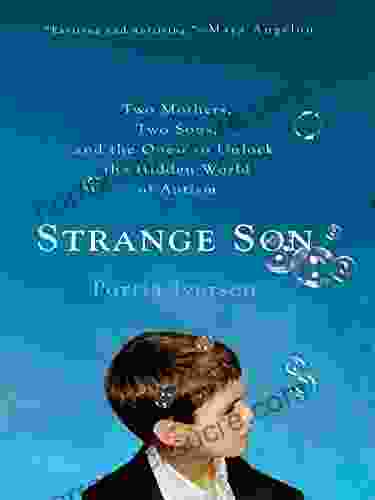
 Drew Bell
Drew BellTwo Mothers, Two Sons, and the Quest to Unlock the Hidden...
When their sons were diagnosed with...

 Bobby Howard
Bobby HowardUnveiling the Rivkah Remnant: Lou Kasischke's Unwavering...
In the tapestry of Christian history,...
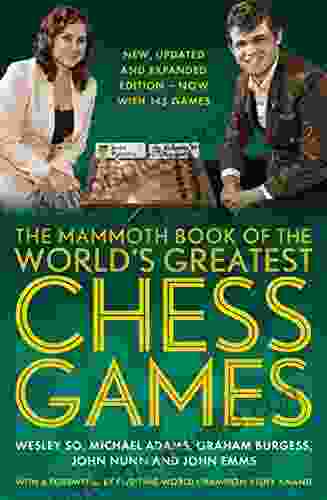
 Alex Foster
Alex FosterThe Mammoth of the World's Greatest Chess Games: An...
Chess, a game of strategy, intellect,...
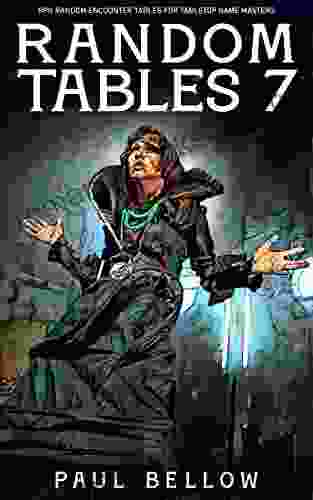
 Aldous Huxley
Aldous HuxleyRandom Tables Fantasy RPG: Random Encounter Tables for...
In the vast tapestry of tabletop role-playing...
4.6 out of 5
| Language | : | English |
| File size | : | 3030 KB |
| Text-to-Speech | : | Enabled |
| Screen Reader | : | Supported |
| Enhanced typesetting | : | Enabled |
| Word Wise | : | Enabled |
| Print length | : | 355 pages |


